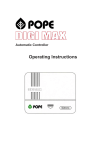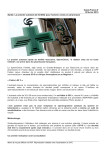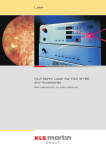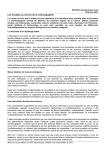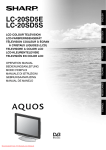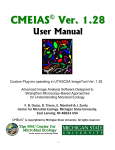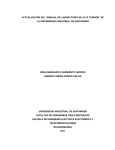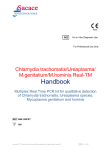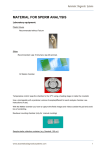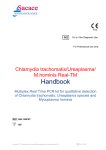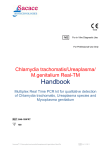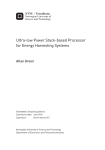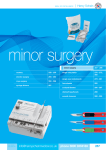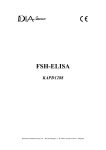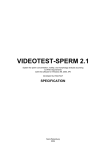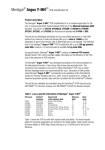Download Clinical and Consumer Trial Performance of a Sensitive
Transcript
Clinical and Consumer Trial Performance of a Sensitive Immunodiagnostic Home Test That Qualitatively Detects Low Concentrations of Sperm Following Vasectomy Kenneth L. Klotz,* Michael A. Coppola,* Michel Labrecque,* Victor M. Brugh, III, Kim Ramsey, Kyung-ah Kim, Mark R. Conaway, Stuart S. Howards,* Charles J. Flickinger* and John C. Herr*,† From the Department of Cell Biology and Center for Research in Contraceptive and Reproductive Health (KLK, CJF, JCH), Department of Public Health Sciences (MRC) and Department of Urology (SSH), University of Virginia, and ContraVac, Inc. (MAC), Charlottesville, and Devine-Tidewater Urology, Virginia Beach (VMB, KR), Virginia, Université Laval, Quebec, Canada (ML), and Princeton BioMeditech Corp., Princeton, New Jersey (KK) Purpose: Compliance with post-vasectomy semen analysis could be improved with the availability of a simple, rapid and accurate home test. SpermCheck Vasectomy®, a highly sensitive lateral flow immunochromatographic diagnostic device, was designed to detect extreme oligospermia or azoospermia in men after vasectomy. We report the results of clinical and consumer testing of SpermCheck. Materials and Methods: A prospective, noncomparative observational study assessed the ability of SpermCheck Vasectomy to predict post-vasectomy sperm counts obtained using a hemacytometer procedure based on standard World Health Organization methodology. Consumer studies evaluated ease of use. Results: A cohort of 144 post-vasectomy semen samples was tested in the clinical trial. SpermCheck was 96% accurate in predicting whether sperm counts were greater or less than a threshold of 250,000 sperm per ml, a level associated with little or no risk of pregnancy. Sensitivity was 93% (95% CI 79% to 98%) and specificity was 97% (91% to 99%). The positive predictive value of the test was 93% (79% to 98%), and most importantly the negative predictive value was 97% (91% to 99%). The test gave a positive result 100% of the time at sperm concentrations of 385,000/ml or greater. Consumer studies with 109 lay volunteers showed that SpermCheck was easy to use. Volunteers obtained the correct or expected test result in every case and the correct response rate on a 20 question survey about the test was 97%. Conclusions: SpermCheck Vasectomy, a simple and reliable immunodiagnostic test that can provide evidence of vasectomy success or failure, offers a useful alternative to improve compliance with post-vasectomy sperm monitoring. It is currently the only Food and Drug Administration approved test for this purpose. Key Words: vasectomy, spermatozoa, cytology, sperm count, instrumentation Vasectomy is a safe and effective method of male contraception. However, men who choose vasectomy must continue to use other birth control methods until residual sperm have been cleared from the reproductive tract. The time necessary to achieve this clearance can be variable,1,2 and compliance with post-vasectomy semen analysis to confirm azoospermia is poor.3–5 The inconvenience of returning to the clinic and the embarrassment associated with providing semen for analysis are cited as reasons for low patient compliance.6 A diagnostic test that men could perform in the privacy of their own home could lead to substantial improvement in this area. Herr et al described an immunodiagnostic device capable of detecting low Submitted for publication March 26, 2008. Study received institutional review board approval. Supported by National Institutes of Health Grant U54 29099, Fogarty International Center Grant D43 TW/HD 00654 and research contracts from ContraVac, Inc. (to JCH) with manufacturing and development expenses underwritten by Princeton BioMeditech Corporation. * Financial interest and/or other relationship with ContraVac, Inc. † Correspondence: Department of Cell Biology and Center for Contraceptive and Reproductive Health, P.O. Box 800732, University of Virginia Health System, Charlottesville, Virginia 22908-0732 (email: [email protected]). For another article on a related topic see page 2706. 0022-5347/08/1806-2569/0 THE JOURNAL OF UROLOGY® Copyright © 2008 by AMERICAN UROLOGICAL ASSOCIATION numbers of sperm.7 This lateral flow immunochromatographic test, SpermCheck Vasectomy, uses monoclonal antibodies that recognize the sperm specific acrosomal protein SP-10. SP-10 has been validated as a selective analyte for measuring sperm concentrations. It is expressed only in the testis and is not found in other organs.8 The SP-10 protein is present in every male,9 is readily released from sperm with mild detergents10 and remains soluble in aqueous solutions. Thus, SP-10 is a postmeiotic, sperm specific biomarker amenable to detection with monoclonal antibodies.11 A direct relationship exists between sperm number and signal strength in enzyme linked immunosorbent assays that measure SP-10 concentrations indicating that an immunodiagnostic device could be developed using the SP-10 analyte.7 In this report we describe optimization, and clinical and consumer testing of SpermCheck Vasectomy, a convenient, easy to use, rapid home test useful for detecting azoospermia or extreme oligospermia in post-vasectomy semen samples. MATERIALS AND METHODS Principle of the Assay The SpermCheck Vasectomy test is a rapid qualitative test that detects the presence of sperm in human semen at 2569 Vol. 180, 2569-2576, December 2008 Printed in U.S.A. DOI:10.1016/j.juro.2008.08.045 2570 CLINICAL AND CONSUMER PERFORMANCE OF HOME SEMEN ANALYSIS TEST FIG. 1. SpermCheck test procedure. After liquefaction measured volume of semen is added to phosphate buffer solution containing 0.1% Triton-X-100. If sperm are present detergent releases SP-10 antigen (analyte) from sperm acrosome into solution. When drops of solution are added to device well, if sperm are present SP-10 antigen is available for antibody binding in test pad and at test line on nitrocellulose membrane. Test line turns reddish purple indicating positive result. concentrations of 250,000 sperm per ml or greater. The test uses solid phase chromatographic immunoassay technology. After liquefaction a volume of semen is mixed with a buffer, applied to the device and the test result is read 7 minutes later (fig. 1). The principle underlying operation of the device is shown in figure 2. Representa- tive test results and their interpretation are described in figure 3. Rationale for Sensitivity Level The risk of pregnancy at low sperm concentrations is a subject of intense debate. On the one hand there are rare FIG. 2. Principle of operation of SpermCheck immunochromatographic device. After mixing semen sample with test solution 4 drops of mixture are dispensed into sample well. Sample fluid migrates by capillarity through pads containing lyophilized detector antibody to SP-10 protein. Detector antibody is conjugated to gold particles. If sample contains sperm, upon hydration of pad by applied sample complexes form consisting of antibody-gold/SP-10 antigen. Immune complexes then flow up nitrocellulose membrane. Membrane serves as solid support upon which capture antibody (test band) and anti-species IgG antibodies (control band) are immobilized. Immobilization of reagents on nitrocellulose membrane in defined areas allows for formation of distinct colored bands that can be read visually. Complex of antibody-gold plus SP-10 antigen is captured by antibody on membrane and reddish purple line appears at test band in device window if sperm are present. If sample contains sperm below detection level, no line appears at test band. Anti-species IgG antibodies are immobilized at control band. Antibodies will bind to excess (unbound) antibody-gold conjugates, resulting in formation of distinct line at control band, telling user that device has worked (flowed) properly. If control line does not appear within designated incubation time, test is invalid and should be repeated. CLINICAL AND CONSUMER PERFORMANCE OF HOME SEMEN ANALYSIS TEST 2571 FIG. 3. Results of SpermCheck tests. Diagnostic devices showing positive (A), negative (B) and 2 types of invalid test results (C and D). Control line must appear to insure result is valid. documented reports of confirmed paternity by men who had multiple semen analyses negative for sperm before and after the pregnancy.12 Conversely studies of couples presenting with primary or secondary infertility show pregnancy rates of less than 1 per 100 person-years of unprotected intercourse when the sperm count is between 1 ⫻ 105 and 1 ⫻ 106/ml.13 Studies of candidate male hormonal contraceptives have shown that suppression of sperm production to severely oligospermic levels (less than 1 ⫻ 106/ml) provides high contraceptive efficacy and that the failure rate is proportional to the residual sperm count.14 –17 On the basis of these findings the consensus emerged that a sperm count less than 1 ⫻ 106/ml is an appropriate target for hormonal suppression of spermatogenesis.18 Taken together these data support the concept that sperm concentrations less than 250,000/ml are associated with little risk of pregnancy. Although there are no consensus guidelines or uniform standards of care for confirming sterility in men who underwent vasectomy, the 1 ⫻ 106/ml value has also been suggested as a cutoff for post-vasectomy sterility.19 Given current knowledge of the relationship between sperm counts following vasectomy and fertility, and with the caveat that even repeatedly documented azoospermia is not an absolute guarantee of sterility, it was decided to develop the SpermCheck Vasectomy device with a nominal detection limit of 250,000 sperm per ml. Assay Development and Optimization Semen samples were collected from healthy normal men and vasectomized subjects. Sperm from normal donor semen were counted using a Neubauer hemacytometer (Hausser Scientific, Horsham, Pennsylvania) and pooled. Pooled seminal fluid from confirmed azoospermic vasectomized donors was used to dilute the normal semen to obtain test samples over a range of low sperm concentrations, which were then used to determine the sensitivity of test lots of SpermCheck Vasectomy devices. When parameters for manufacturing devices with the desired sensitivity had been established, 2 production lots of 3,000 devices each were produced. Sensitivity and precision studies confirmed that these devices gave positive or negative results with semen samples ranging in sperm concentration from 0 to 706,000/ml (data not shown). Clinical Study Design All studies involving human subjects were reviewed and approved by institutional review boards at the sites where patients were recruited and testing was performed. The performance of SpermCheck Vasectomy was compared to the generally accepted standard procedure of determining sperm concentration with a hemacytometer (the predicate device). The study used patient samples obtained at various intervals after vasectomy. To obtain approximately 25% semen samples with sperm concentrations high enough to give positive test results, some patients were asked to provide specimens at earlier times following surgery than would normally be the case for post-vasectomy semen analyses. Patients who underwent vasectomy who volunteered for the study were asked to return to the clinical laboratory and provide a fresh semen sample as normally required by their physician for routine followup after the procedure. They were given the option of bringing 1 or more additional samples from the second through sixth ejaculate after vasectomy. The patients collected samples in private at the clinic or, if they preferred, at home within 2 hours of presenting the sample. A physician or technician in the physician’s office performed the SpermCheck test with the patient’s sample by following the instructions provided in the kit. A determination of sperm concentration was then made with a hemacytometer following the standard operating procedures. Technicians performing the hemacytometer counts were previously trained in these procedures. This was a blinded study and the person performing the hemacytometer count had no knowledge of the results from the SpermCheck Vasectomy test. Standard Operating Procedure for Determining Sperm Concentration Samples with relatively abundant spermatozoa were appropriately diluted with bicarbonate/formalin buffer and 2 independent counts of at least 200 sperm each were performed.20 Both chambers of an improved Neubauer hemacytometer (Hausser Scientific, Horsham, Pennsylvania) were scored and the average count recorded, provided that the difference between the 2 counts did not exceed 5% of their sum (both values were within ⫾ 5% of the average). If the 2 counts were not within ⫾ 5% of their average, no result 2572 CLINICAL AND CONSUMER PERFORMANCE OF HOME SEMEN ANALYSIS TEST was recorded. The sample then was remixed, and another hemacytometer was prepared and counted. The number of 1 mm squares that were counted to reach a minimum of 200 sperm varied depending on the sperm concentration. To calculate the concentration of sperm in the sample the average number of sperm in a 1 mm square was determined by dividing the total number of sperm counted by the number of squares counted. This quotient was multiplied by the dilution factor, if any, and the result was multiplied by 104 to give spermatozoa per ml. Analysis of Semen Samples With Low Sperm Concentrations Semen samples with low sperm concentrations were not diluted or centrifuged before counting. The hemacytometer was placed in a humidified chamber for 10 minutes to allow sperm to settle. Two independent counts were performed. A minimum of 200 sperm were counted on each side of the hemacytometer and the 2 counts averaged. If the 2 counts did not agree within ⫾ 5% of their mean, results were not recorded, a new hemacytometer was prepared and 2 independent counts were performed again. Analysis of Semen Samples With Sperm Concentrations Less Than 111,000/ml If fewer than 200 sperm were counted in all 18, 1 mm squares on both sides of a hemacytometer, then the sperm concentration was less than 111,000/ml. In such cases 5 separate hemacytometers were prepared and counted. The count for each side (9 squares) of all 5 hemacytometers (90 squares total) was used to calculate the mean sperm concentration with 95% confidence intervals. Consumer Study Design Two consumer studies were performed. In the first study a total of 51 subjects were enrolled, 31 who had undergone vasectomy and 20 who had not. A total of 50 men completed the study (1 who had a vasectomy withdrew from the study before completing the testing). Participants ranged in age from 18 to older than 65 years and in education from high school graduates to holders of advanced academic and professional degrees, and were employed in a range of occupations. Subjects were provided a test kit with printed instructions. Subjects performed the test at home with their own semen sample, recorded the test result, and answered questionnaires about the test, instructions and results (see Appendix). The subjects then returned the questionnaire and the remainder of the semen sample to the laboratory where the SpermCheck test was repeated and a hemacytometer count performed. Thus, this study compared lay vs professional users and also compared SpermCheck to the predicate device. In the second consumer study volunteers were provided with semen samples at known sperm concentrations along with test kits and instructions. Subjects performed the SpermCheck test at the study site without assistance, recorded the results and answered a questionnaire. This group of 37 nonnative and 16 native English speaking subjects (17 to 67 years old) included 10 high school graduates, 29 college graduates and 13 with advanced degrees. Of the participants 10 were women. The test samples for this study were prepared by diluting a pool of semen from normal donors with semen from azoospermic vasectomized donors to obtain sperm concentrations of 17,000, 350,000 and 1,000,000/ml. RESULTS Clinical Trial The results of SpermCheck Vasectomy testing and hemacytometer counting of 144 semen samples provided by 100 patients who underwent vasectomy are depicted in figures 4 and 5. A summary of the data is provided in tables 1 and 2. Of the 40 semen samples with sperm concentrations greater than 250,000/ml 37 tested positive for the presence of sperm with the device (93% sensitivity). Of the 104 samples with sperm concentrations less than 250,000/ml 101 tested negative (97% specificity). The overall accuracy of SpermCheck in predicting whether the sperm concentration determined by hemacytometer counting was greater or less than the threshold value of 250,000/ml was 96%. The PPV of the test was 93% and the NPV was 97%. Consumer Testing There was 100% agreement between the SpermCheck Vasectomy results obtained by 50 home users and those obtained by laboratory personnel retesting the same semen samples. There was 1 disagreement between the SpermCheck Vasectomy results and the hemacytometer counts among the 50 tests (98% agreement). Each of the 59 participants in a second consumer study tested 3 prepared, coded semen samples for a blind study. All subjects obtained the expected SpermCheck Vasectomy test result with each sample. The participants in both consumer studies completed the same questionnaire after performing the SpermCheck Vasectomy test (see Appendix). The results are presented in table 3, and indicate that users found the test easy to perform and were able to understand the instructions, correctly reading and interpreting their test result. DISCUSSION SpermCheck Vasectomy was highly accurate in predicting whether sperm count was greater or less than 250,000/ml. Most of the few discordant results observed were within a narrow range of sperm concentrations and could be due to errors in sperm counting rather than diagnostic device failures. Of the 6 discrepant samples 5 had sperm concentrations close to the cutoff level of 250,000 sperm per ml. Two false-positive results were observed with sperm concentrations of 235,000 and 246,389 sperm per ml, while 3 falsenegative results were observed with sperm concentrations of 296,667, 365,556 and 384,722 sperm per ml. Determination of low sperm counts is notoriously inaccurate even with a rigorous counting protocol such as that used in this study. When we consider the inherent error rates of hemacytometer counting at these low sperm concentrations, it is difficult to state with certainty that any of these discrepant SpermCheck results were truly incorrect.20,21 One other falsepositive sample had a low sperm concentration (667 sperm per ml). Sensitivity (and, thus, negative predictive value) is the most important parameter to consider in evaluating the performance of SpermCheck Vasectomy since a false-negative test could potentially lead to an unwanted preg- CLINICAL AND CONSUMER PERFORMANCE OF HOME SEMEN ANALYSIS TEST 2573 FIG. 4. Summary of clinical testing of SpermCheck Vasectomy. Total of 101 men were recruited consecutively from among patients seeking vasectomy at 2 clinics between May 2006 and February 2007. One participant was lost to followup before providing any semen samples for analysis, leaving 100 subjects enrolled in trial. Men donated total of 145 semen samples for testing but 1 result was excluded from analysis since SpermCheck test was not performed correctly. Of 145 semen samples tested 144 were included in analysis, 60 early post-vasectomy samples and 84 regular clinical followup samples. the 250,000 sperm per ml cutoff the sensitivity of the device is such that one can predict a positive result 100% of the time when sperm concentrations are 385,000/ml or greater. Given that 385,000/ml is well below the 1 million per ml level targeted in many studies of male contraceptives, the SpermCheck Vasectomy device may also be of value in measuring the decline into oligospermia in trials of male contraceptives. sperm concentration (per milliliter) nancy (the only consequence of a false-positive result is the need for retesting at a later date). The highest sperm concentration of any semen sample that gave a negative SpermCheck result was 384,722/ml according to the hemacytometer count. Thus, within this cohort a negative result indicated that the sperm concentration was no higher than approximately 385,000/ml. Stated another way although the device shows some variability around negative positive test result FIG. 5. Plot of sperm concentrations by test result with horizontal line at concentration of 250,000/ml 2574 CLINICAL AND CONSUMER PERFORMANCE OF HOME SEMEN ANALYSIS TEST TABLE 1. Results of the SpermCheck Vasectomy clinical trial Sperm Count Less Than 250,000 Greater Than 250,000 Totals SpermCheck pos SpermCheck neg 3 101 37 3 40 104 Totals 104 40 144 The data from 2 separate consumer studies with a diverse cohort of more than 100 volunteers showed that lay users can correctly follow the instructions, obtain expected test results and correctly interpret the meaning of these results when using SpermCheck Vasectomy. One question concerning the importance of communicating test results to the physician caused some confusion, with 17% incorrect responses. Test instructions were modified to clarify and emphasize this point. The sole discordant test result in the home use study involved a semen sample from a man who had undergone vasectomy 2 years earlier. Both the study subject and the professional user obtained a presumptive false-positive SpermCheck result with this sample. Interestingly the semen sample was not azoospermic but had a sperm concentration of 7,000/ml by hemacytometer counting. These few sperm were not motile. A subsequent semen sample from the same donor was negative by SpermCheck and hemacytometer. Similar intermittent reappearance of sperm late after vasectomy has been reported by others.12 It is important to note the lack of a true standard of care or even clear and uniform guidelines regarding what consti- TABLE 2. Statistics from the SpermCheck Vasectomy clinical trial % (95% CI)* Prevalence of sperm counts greater than 250,000/ml in tested population Sensitivity in detecting sperm counts greater than 250,000/ml Specificity in detecting sperm counts less than 250,000/ml For any particular pos test result, probability that it is: True positive (PPV) False-positive For any particular neg test result probability that it is: True neg (NPV) False-neg 28 (21–36) 93 (79–98) 97 (91–99) 93 (79–98) 8 (2–22) 97 (91–99) 3 (1–9) * Calculated according to the efficient score method (corrected for continuity) described by Newcombe.22 TABLE 3. Results of consumer surveys No. neutral-strong agreement/total No. (%): Section 1–ease of use ⫹ clarity of instructions No. correct answers/total No. (%): Section 2–performing test Section 3–reading ⫹ understanding test results 855/872 (98) 646/654 (99) 620/654 (95) A total of 109 consumers completed this survey which consisted of 8 questions in section 1, and 6 questions in sections 2 and 3 for 872 and 654 responses, respectively (see Appendix) tutes acceptable evidence for declaring a vasectomy successful. It is not within the scope of this report to debate the merits of various standards for post-vasectomy semen analysis, nor is it our intent to suggest that a single SpermCheck Vasectomy test, in and of itself, represents a new standard for clearing patients to discontinue other methods of contraception following vasectomy. While SpermCheck cannot provide proof of sterility it is clear from the literature that microscopic sperm counting does not constitute such proof either. Unfortunately many patients apparently decide that their procedures were successful without any evidence and without adequate consultation. In this context we believe that SpermCheck Vasectomy can have a role in improving compliance, and improving communication between patients and their physicians. CONCLUSIONS SpermCheck Vasectomy is a fast, simple, sensitive and reliable home test that can provide patients with useful information about sperm counts when used at appropriate times after surgery. It may also be used at longer intervals to give assurance against late recanalization or to confirm recanalization when pregnancy has occurred after vasectomy was considered successful. SpermCheck Vasectomy may prove to be a useful adjunct to current practice in post-vasectomy sperm detection, and the availability of this convenient and economical home testing option could improve patient compliance. The Food and Drug Administration approved this device for qualitative detection of low concentrations of sperm following vasectomy in January 2008. ACKNOWLEDGMENTS Annie Goulet, Martin Laforest and Ann Villeneuve from PROCREA Cliniques, Québec, Canada (www.procrea.com) provided study assistance. APPENDIX Questionnaire for home testing consumer trial participants SpermCheck® Vasectomy Please indicate your agreement with each statement below using a 1–5 scale, where 1 ⴝ strongly disagree and 5 ⴝ strongly agree. 1. The test instructions were easy to understand. ( ) 2. It was easy to follow the instructions. ( ) 3. The answers to frequently asked questions were helpful. ( ) 4. It was easy to add the semen to the SpermCheck Solution Bottle. ( ) 5. It was easy to apply the mixed sample to the test device. ( ) 6. Reading the test result was easy. ( ) 7. The control line was clearly present and easy to read. ( ) 8. The instructions clearly explain what to do if a test result is invalid. ( ) The following are multiple choice questions about performing the test. Please circle the letter of the best answer to each question. Please mark only one answer for each question. You may refer to the package insert at any time as you answer these questions. (appendix continued) CLINICAL AND CONSUMER PERFORMANCE OF HOME SEMEN ANALYSIS TEST 2575 APPENDIX continued 9. After collecting your semen sample, how long should you wait before adding it to the SpermCheck Solution Bottle? a. 15 to 30 minutes b. at least 10 minutes c. at least 20 minutes, but not more than 3 hours d. you should start the test immediately 10. When you remove semen from the Semen Collection Tube to add to the SpermCheck Solution Bottle, it is important to a. use the dropper to mix the semen sample b. avoid solid or sticky material c. avoid air bubbles d. do all of the above 11. How much semen should you add to the SpermCheck Solution Bottle? a. fill the dropper to the bottom line b. fill the dropper to the middle line c. fill the dropper to the top line d. you should add all of the semen sample to the bottle 12. After mixing the semen with the SpermCheck Solution, how long should you wait before adding the sample to the sample well of the test device? a. 1 minute b. 2 minutes c. 5 minutes d. 20 minutes 13. How many drops of the semen/solution mixture should you add from the SpermCheck Solution Bottle to the sample well of the test device? a. 1 drop b. 2 drops c. 4 drops d. 8 drops 14. When should you read the test result? a. no more than 7 minutes after adding the sample to the device b. exactly 7 minutes after adding the sample to the device c. at least 7 minutes after adding the sample to the device d. as soon as you see the control line The following are true or false questions about reading your test and understanding the results. Please mark (T) for true and (F) for false statements. You may refer to the package insert at any time as you answer these questions. 15. If the test result is positive, other birth control methods should still be used. ( ) 16. An invalid test means the result is negative. ( ) 17. A weak signal at the test line position with a clear control line is a negative result. ( ) 18. If the test result is negative the sperm count is very low and the risk of pregnancy is extremely small. ( ) 19. If the test result is positive you should wait two weeks and test a new sample. ( ) 20. If your result was negative, you should talk to your doctor about your decision to stop using other birth control. ( ). Abbreviations and Acronyms NPV ⫽ negative predictive value PPV ⫽ positive predictive value SP-10 ⫽ sperm protein 10 [ARCV1 gene product] 9. 10. REFERENCES 1. 2. 3. 4. 5. 6. 7. 8. Alderman PM: General and anomalous sperm disappearance characteristics found in a large vasectomy series. Fertil Steril 1989; 51: 859. Barone MA, Nazerali H, Cortes M, Chen-Mok M, Pollack AE and Sokal D: A prospective study of time and number of ejaculations to azoospermia after vasectomy by ligation and excision. J Urol 2003; 170: 892. Christensen RE and Maples DC Jr: Postvasectomy semen analysis: are men following up? J Am Board Fam Pract 2005; 18: 44. Maatman TJ, Aldrin L and Carothers GG: Patient noncompliance after vasectomy. Fertil Steril 1997; 68: 552. Belker AM, Sexter MS, Sweitzer SJ and Raff MJ: The high rate of noncompliance for post-vasectomy semen examination: medical and legal considerations. J Urol 1990; 144: 284. Smucker DR, Mayhew HE, Nordlund DJ, Hahn WK Jr and Palmer KE: Postvasectomy semen analysis: why patients don’t follow-up. J Am Board Fam Pract 1991; 4: 5. Herr JC, Klotz KL, Anderson P, Adams E, Moore N and Howards SS: Progress in developing an immunochromatographic device for sperm detection. Clin Immunol Newsl 1999; 19: 52. Freemerman AJ, Wright RM, Flickinger CJ and Herr JC: Tissue specificity of the acrosomal protein SP-10: a contra- 11. 12. 13. 14. 15. 16. 17. ceptive vaccine candidate molecule. Biol Reprod 1994; 50: 615. Herr JC, Klotz K, Shannon J, Wright RM and Flickinger CJ: Purification and microsequencing of the intra-acrosomal protein SP-10. Evidence that SP-10 heterogeneity results from endoproteolytic processes. Biol Reprod 1992; 47: 11. Herr JC, Flickinger CJ, Homyk M, Klotz K and John E: Biochemical and morphological characterization of the intraacrosomal antigen SP-10 from human sperm. Biol Reprod 1990; 42: 181. Shen M, Wright RM, Carta G and Herr JC: Assay for recombinant and native human intraacrosomal antigen SP-10. Am J Reprod Immunol 1993; 29: 231. Smith JC, Cranston D, O’Brien T, Guillebaud J, Hindmarsh J and Turner AG: Fatherhood without apparent spermatozoa after vasectomy. Lancet 1994; 344: 30. van Zyl JA and Menkveld R: Oligozoospermia: recent prognosis and the outcome of 73 pregnancies in oligozoospermic couples. Andrologia 2006; 38: 87. Turner L, Conway AJ, Jimenez M, Liu PY, Forbes E, McLachlan RI et al: Contraceptive efficacy of a depot progestin and androgen combination in men. J Clin Endocrinol Metab 2003; 88: 4659. Gu YQ, Wang XH, Xu D, Peng L, Cheng LF, Huang MK et al: A multicenter contraceptive efficacy study of injectable testosterone undecanoate in healthy Chinese men. J Clin Endocrinol Metab 2003; 88: 562. Contraceptive efficacy of testosterone-induced azoospermia in normal men. World Health Organization Task Force on methods for the regulation of male fertility. Lancet 1990; 336: 955. Contraceptive efficacy of testosterone-induced azoospermia and oligozoospermia in normal men. Fertil Steril 1996; 65: 821. 2576 CLINICAL AND CONSUMER PERFORMANCE OF HOME SEMEN ANALYSIS TEST 18. Nieschlag E and 10th Summit Meeting Group: 10th Summit Meeting consensus: recommendations for regulatory approval for hormonal male contraception. October 22-23, 2006. Contraception 2007; 75: 166. 19. De Knijff DW, Vrijhof HJ, Arends J and Janknegt RA: Persistence or reappearance of nonmotile sperm after vasectomy: does it have clinical consequences? Fertil Steril 1997; 67: 332. 20. World Health Organisation: WHO Laboratory Manual for the Examination of Human Semen and Sperm-Cervical Mucus 21. 22. Interaction, 4th ed. Cambridge: Cambridge University Press 1999; chapt 2, pp 14-17 and chapt 4, p 37. Sperm concentration. In: Manual on Basic Semen Analysis. Nordic Association for Andrology and European Society for Human Reproduction and Embryology 2002; chapt 4, pp 7-13. Available at www.andrology.dk/manual2002.pdf. Newcombe RG: Two-sided confidence intervals for the single proportion: comparison of seven methods. Stat Med 1998; 17: 857.








